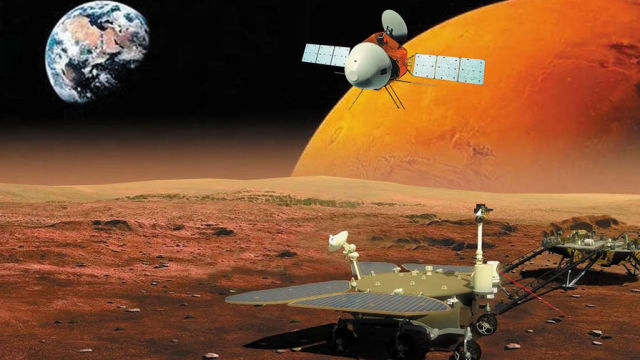Chinese spacecraft with rover on board reaches Mars
The Chinese mission "Tianwen-1" with a rover on board has reached the orbit of Mars. If all goes according to plan, the Chinese rover will land on the surface of the planet in the spring.
Six months after the launch, the Chinese science mission "Tianwen-1" has achieved its goal - the spacecraft, launched last summer, reached Mars and entered orbit around it, according to the publication New Scientist.
If all goes according to plan, in May, the lander will separate from the orbiter and make a soft landing on the surface of the planet together with the rover.
The first Chinese spacecraft to explore Mars was Inho-1, launched alongside the Russian Phobos-Grunt spacecraft in 2011 - a launch that failed.
The launch of the Chinese mission on July 22, 2020 was one of three launches of spacecraft to Mars - the same ballistic window, when Mars was at a minimum distance from Earth (58 million kilometers), the United States and the United Arab Emirates used to launch their missions, whose probe entered the orbit of Mars just the day before.
Experts note that the successful landing of the rover on the surface of the planet will be a major technological success for China, which has previously been able to land its rover on the far side of the Moon, given that according to statistics, only half of all attempts to land vehicles on Mars were successful.
If successful, the mission will not only be another top-notch for Chinese engineers, but will also add to the list of rovers ever launched from Earth. The first such was the American Pathfinder in 1997, followed by Spirit and Opportunity in 2004, and Curiosity in 2012, which is still working today.
The Chinese mission to Mars is the first in the history of the national space program and is inherently unique - it consists of an orbiter, a lander and a rover.
"Tianwen-1 should enter orbit, land and release the rover on the first attempt and coordinate observations with the orbiter," Chinese scientists wrote in the journal Nature Astronomy on the eve of the launch. "No space mission has ever been carried out in this way."
With the" triple "mission, China hopes to conduct a" global and extensive exploration of the entire planet." Among the main objectives of the mission, formulated in 2018, there are five:
- Create a geological map of Mars.
- Study of the characteristics of the Martian surface and possible deposits of water ice.
- Study of the surface composition.
- Study of the Martian atmosphere and climate.
- Analysis of the electromagnetic and gravitational fields of the planet.
The orbiter, which will remain in orbit around the planet, has seven scientific instruments. It carries two cameras, a ground-penetrating radar, a spectrometer for analyzing the mineral composition of the surface, and instruments for analyzing charged particles in the planet's atmosphere.
The exact landing site of the rover has not yet been chosen, but earlier it was reported that it will land in the area of the Utopia Plain-a lowland with a diameter of about 3300 km in the eastern part of the northern hemisphere of Mars, where the American Viking spacecraft landed in the 70s.
The exact date of landing is also not yet known, it is expected that it will take place in 2-3 months.
The rover is six-wheeled, powered by solar panels, and designed for three months of operation on the surface. The estimated lifetime of the orbiter is one Martian year. In addition to the scientific tasks, the orbiter will act as a radio relay for Earth's communication with the rover.
Receiving scientific information and telemetry from Mars will be conducted by a newly built 70-meter antenna in the city of Tianjin in northern China. Construction of the antenna began in October 2018, and the 2,700-ton dish itself was installed in April 2020.
Later in February, the third mission in a month will arrive to Mars - the American Perseverance rover with the first ever Martian helicopter on board, it was launched on July 30, 2020.
Nikolai Gorodetsky

